Introduction
The Mastaba of Sabu (Tomb 3111, c. 3100-3000 BC) was excavated by Walter B. Emery on January, 10th of 1936 at the plateau edge of North Saqqara, approximately 1.7 km north of Djoser’s Step Pyramid (Fig. 1). Sabu was a high official or administrator of a town or province possibly called “Star of the family of Horus” during the reign of the First Dynasty Kings Udima (Den) and Enezib (Anedjib) (Emery 1949).

General Description of Tomb 3111
The superstructure of Tomb 3111 was surrounded by a palace facade made of mud brick, which exhibited the deeply recessed, niched walls indicative of Sabu’s high social status (Fig. 2). Early 1st Dynasty mastaba facades were originally plastered and the recessed panels painted yellow to imitate wood, and the broadest forward faces painted in a variety of square, cross, and lozenge patterns to imitate woven reed-mats. This may have represented the wood frame and woven reed-mats structures of Predynastic shrines that became characteristic of archaic Upper and Lower Egypt (Lehner 1997). In the south corner of the superstructure was located a platform of roughly dressed limestone blocks. Emery (1949) suggests that this is likely a temporary structure possibly used during the funerary ceremony of Sabu.
The interior of the mastaba consisted of a seven roomed substructure located in a pit cut to a depth of 2.55 m into the gravel substrate and limestone bedrock (Fig. 2). The rooms were separated by mud brick walls. The mud bricks were made of a dark black earth mixed with straw and averaged about 0.26 by 0.12 by 0.07 meters in size.

Room A was found intact and exhibited walls with traces of mud plaster and a roof made of wooden planks. The room was filled with 96 pottery vessels, some of which had domed and conical seals bearing the names of King Den and Sabu.
Room B was similar in design to room A. The room contained many articulated ox bones and the remains of what was originally large pieces of meat in proximity to 5 pottery bowls.
Room C exhibited walls with traces of mud plaster and a roof made of wooden planks supported by a socketed wooden beam positioned on the east and west facing walls. The room contained 71 pottery vessels, some of which had conical seals, but none bore names or impressions.
Room D was similar in design to room C. The room was found to be almost empty, containing only a few fragments of stone vessels and pottery.
Room E was the burial chamber. The brick walls were covered in mud plaster, which also exhibited traces of white stucco. The roof of wood planks was supported by three wooden beams socketed into the east and west facing walls. The burial chamber contained the remains of Sabu, which was the first time a noble of the First Dynasty was found in the position that it was originally placed at the time of burial. His body was positioned on its right side in a slightly flexed position with the head in a northerly direction (Fig. 3). The tomb was ransacked at some time it its history, but still exhibited some semblance to the original placement of objects. These objects consisted of copper and flint implements, 77 pottery vessels, ivory boxes, bones of 2 oxen, arrows, and stone vessels.

Most of the 48 stone vessels in the burial chamber were found broken and represented 20 different types of stone vessel forms. The material used for these vessels consisted of travertine (39), metasiltstone (7), and volcanic tuff (2). One of the stone vessels was the elaborately designed metasiltstone ornamental tri-lobe bowl (Fig. 4) which was originally found crushed and scattered around the center of the tomb. The flint implements consisted of many small knives (85) and a few triangular scrappers (5).
Room F and G are similar in design to rooms A and B. Room F contained pottery fragments and a number of sealings bearing the name of King Anedjib. Room G contained scattered fragments of stone vessels and pottery.
The Ornamental Tri-lobed “schist” Bowl
The ornamental tri-lobed bowl has a maximum diameter of 61 cm and a maximum height of 10 cm (Emery 1949). Since originally found crushed it has been restored, and is now on display in the Cairo Museum (JE71295, Fig. 4).
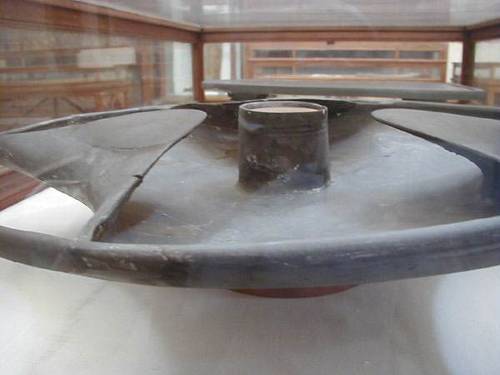
The vessel consists of a flat, round-bottomed bowl with 3 thinly carved, curved lobes orientated at 120 degrees around the periphery. Very flat and wide bowls are known from the 1st to 3rd Dynasties, but none have been found from the Predynastic Period (El-Khouli 1978). The lobes are separated from the rim by 3 biconvex-shaped perforations (Fig. 5). The center of the vessel contains a thinly carved tube approximately 10 cm in diameter (Fig. 6). When viewed edge on the vessel’s flat bowl shape does not show perfect symmetry (Anthony Sakovich personal comm., Fig. 7).

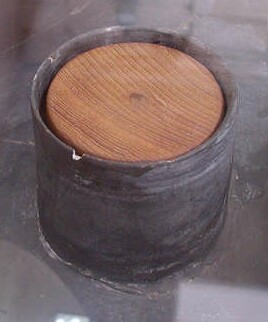

In the past, some Egyptologists have use the term “schist” to describe this artifact (Emery 1949, Aldred 1981); others have identified the object as a slate (Smith 1981). The term schist was not being used in a modern geologic context (i.e. a medium- to coarse-grained foliated metamorphic rock), but was being used to describe a metasedimentary rock called a metasiltstone. This rock is essentially the sedimentary rock siltstone that has been very weakly metamorphosed. It still retains its clastic sedimentary texture and has no visible schistosity. Metasiltstone is similar to slate, but is more coarse-grained and has no fissisity or slaty cleavage, making it a solid rock that does not easily fracture along discreet planes when struck. The weak metamorphism of siltstone indurates the rock and increases the cohesiveness of the mineral grains (i.e. rock hardness), making the rock less susceptible to fracture during carving. This allows for fine detail and intricate shapes to be carved into vessels, statues, palettes, and other such objects. Metasiltstone as a material for vessel manufacturing came into use during the middle Predynastic and was used extensively during the Early Dynastic Period (Aston 1994). Besides the tri-lobed bowl there are a number of intricately carved metasiltstone objects known from the Early Dynastic, such as a very ornate toilet tray (Fig. 8), flower-shaped vessels (e.g. 1st Dynasty, UC37063 (Note: identified as greywacke but more likely metasiltstone, metagreywacke was not used until the Old Kingdom and not for vessels (Nicholson & Shaw 2000))), vessels shaped as leaves (e.g. 1st-2nd Dynasty, UC35653), vessels shaped to imitate basket-work (e.g. 1st-2nd Dynasty, UC35654), vessels shaped as hieroglyphic symbols (e.g. 1st Dynasty, libation dish), and even used to imitate metal vessels (e.g. a stone vessel with simulated rivet-heads (Lauer 1976, pl. 109). Many of these sophisticated and creative designs are unique to the Early Dynastic Period, showing a high degree of experimentation in artistic expression during this time.

Possible Usage for Tri-lobed Bowl
Emery (1972) suggests that the artifact may have been carved in the imitation of a metal vessel’s form, with a center hole that was originally designed to fit on a pedestal. Possible competition between metal and stone vessel artisans may have been one of the reasons for the development of artistic expression in ornamental stone vessel forms during the Early Dynastic Period (El-Khouli 1978). William Kay (Link) has suggested that the vessel was a ritualistic tri-flamed oil lamp, in which bundles of rushes, immersed in oil, acted as the wicks. These bundles of rushes were held in place by the lobes, and the vessel was suspended on a pedestal inserted through the center. Whether it was actually used for this purpose is uncertain. The fragile nature of such an intricately carved stone object greatly limits is practical usage and suggests a purely ornamental function, being of a religious or other such ritualistic purpose.
Although it has been suggested the vessel was meant to be held on a pedestal, the center tube may also have been used as a stand for holding another vessel or object. Smith (1981) has suggested that the center tube was a container. Tubes of rock were used by the ancient Egyptians to hold round-bottomed vessels, and there are many examples of these throughout the dynastic Egypt, including from the Early Dynastic Period (El-Khouli 1978).
Another object that resembles the tri-lobed bowl is a clay snakes figurine from the Nagada II period (Petrie c1974, Fig. 9, UC15361). The object consists of a round disk with four snakes, in which three are represented as raised heads (possibly cobras) orientated at 120 degrees around a central, round-shaped vessel with a fourth snake appearing to drink from it, and three horn-shaped indentations around the periphery. The three raised snakes each has an extra eye on their backs made of ostrich eggshell.
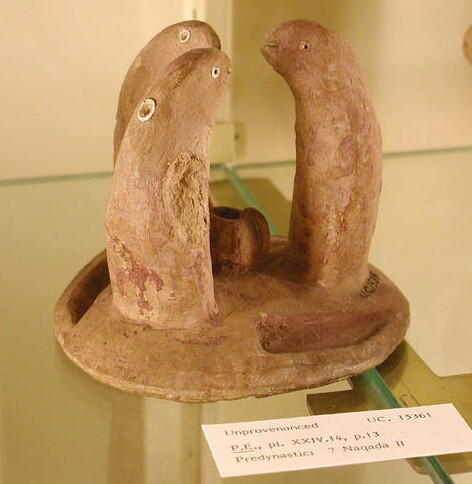
The use of these early figurines and their religious or magical significance to the ancient Egyptians is not well understood. Animal figurines were often associated with offerings to religious shrines for a variety of early deities. There are a number of Predynastic objects, as well, that depict a close association between snakes (serpents or cobras) and elephants. These snakes either lead or are underneath elephants in a procession (Fig. 10, UC15266), and are often associated with many other animals, including lions, birds, horned oxen, and other quadrupeds. In some examples, these snakes are thought to represent early depictions of the uraeus cobra because of the raised head and neck typical of these species of snakes (Johnson 1990). The horn shaped indentation around the periphery of the clay figurine above may be a simplified representation of an elephant in the form of a tusk-shaped symbol, and 3 associated serpents/cobras leading them in procession. Although the other Predynastic objects do not depict what the serpents are actually leading the procession of animals to, in the case of the clay figurine above it may be that this is some form of liquid. This liquid may represent a source of water, since snakes during dry seasons are usually found in close proximity to water, and the Nile during inundation usually flushes them out of the area in great numbers. If this is the case, the snakes may be symbolically leading game animals to areas where they can congregate in proximity to water, such as an oasis or the Nile, so that hunting of them could be more easily accomplished. Whether the tri-lobed bowl represents a similar symbolism is uncertain, although the lobes resemble the shapes of serpent/cobras heads in an abstract form, the biconvex shape is common to the representation of intertwined snakes (Fig. 10 a-b), and a central tube suggests a stand for a vessel.
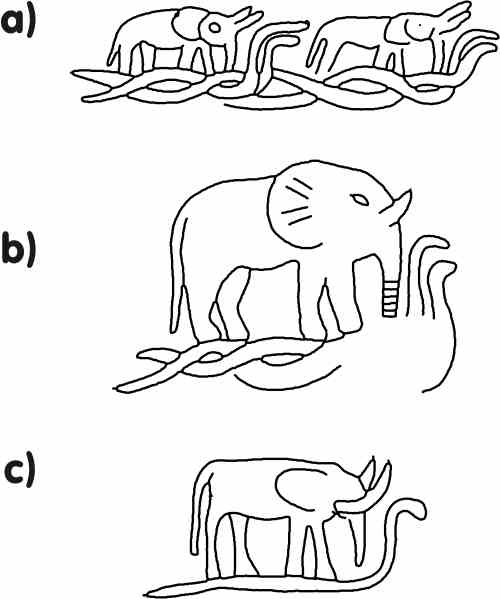
Method of Manufacture
As a result of the finished nature of this stone vessel the exact method of manufacturing will never be completely known. No detailed examination of its surface has been published in the archeological literature. Detailed surface examination can yield some light on the final steps of carving and polishing, but the sequence of many of the earlier steps generally cannot be determined from this method. We can suggest a series of plausible steps that will lead to the manufacturing of this object from assumptions based on the tools and materials that can be attributed to the ancient Egyptians, unfinished ancient works of stone in various stages of completion, and basic lapidary and percussion techniques that have been used through the long history of rock carving. This is not to say that this is the only way the object can be made, since the order of the steps can differ to some degree, and as well, different techniques could also have be used. The purpose is to demonstrate that a series of simple techniques are capable of manufacturing this object.
The first step would be the procurement of a suitable rock. This would be a hard rock free of fractures and other structural weaknesses. The metasiltstones of the Wadi Hammamat quarries, which have been worked since Predynastic times, are such a rock, being composed of silt-sized sedimentary particles embedded in a compact clay matrix (Aston 1994, Nicholson & Shaw 2000). The rock, being slightly metamorphosed, is both hard in terms of compressive fracture strength and soft in terms of its susceptibility to abrasion. These two properties of this rock aid in its carving into complex forms. After quarrying, the rock could be shaped into a block with the use of a hand-powered lapidary saw, possibly similar in design to that used by Stocks (2001, Fig. 11). Metasiltstone would not be a difficult rock to cut by abrasion with quartz abrasive because of the softness of the clay matrix. The size of the block would need to be larger than the maximum dimensions of the finished vessel to allow for oversizing during the carving of complex detail.


The planning of the desired shape of the object is very important in the carving of rock. The steps of manufacturing would be carefully worked out before the vessel’s manufacturing was started. Attention would be paid to minimizing as much as possible the work that would be needed to finish the vessel. To start the center of the block could be marked, and a circle, with a radius larger than the vessel’s finished radius of 30.5 cm, is drawn in paint onto the block’s upper surface with a cord compass, circular template, or other such method (Fig. 13).

This can be followed by the cutting of the vessel’s initial cylinder shape with a small lapidary saw using quartz abrasive (Fig. 14). This would involve faceting the corners of the block repeatedly so that the waste rock is removed from the edges of the painted circle.

An example of the faceting of a small unfinished statuette of vein quartz demonstrates the removal of waste rock and the rough shaping of the front and sides by the use of a small lapidary saw (e.g. UC16617, Petrie c1974).
At some stage in the manufacturing the position of detail will be drawn on the surfaces of the block (Fig. 15). The use of drawn locations of planned cuts by the ancient Egyptians is known from examples of stone vessels (Fig. 16).


The making of the outer surface of the bowl would most likely be next. Accomplishing this would involve similar methods as in the manufacturing of other stone vessels, palettes, and statues that were often made out of this same type of rock. This would involve copper chisels, as well as, stone grinding and gouging tools. Copper chisels have been noted to work on metasiltstone and slate (Warden 2000). The vessel may at this point have been mounted in a frame or other such device to protects its outer bowl-shaped surface once completed. El-Khouli (1978) has observed modern stone vessel makers at Luxor poring a glue over the outer surfaces of preworked vessels and then wrapping the outer surface in several layers of cloth. It is likely this was being used mainly to strengthen and protect the vessel during the working process.
The hollowing and carving of the interior detail would be next. They may have started with the cutting of the center rock tube (Fig. 17). This can be done using the techniques demonstrated by Stocks (1993) with the use of hand-powered lapidary coring drills of varying diameters. The inner core would be completed first, being cut completely through the center of the vessel, releasing the rock core. The center hole may have been filled with something that would strengthen it, but could be easily removed after the vessel was completed (e.g. clay, resin, wax, glue socked cloth, etc.). This would protect the areas of weakness and lessen the possibility of the vessel’s breakage during the rest of the manufacturing process. A second hole would be cut with a larger diameter than the first, but not entirely through the vessel, stopping short of the desired thickness of the vessel’s form at that position. This would produce a tube of rock in the center that is still attached, but separated from most of the surrounding rock (Fig. 18). The tube would be cut thicker than its finished state so that more strength is produced during these initial stages of shaping the vessel. The tube can be carefully ground down by hand to its desired thickness and shape during the final stages of the vessel’s completion.
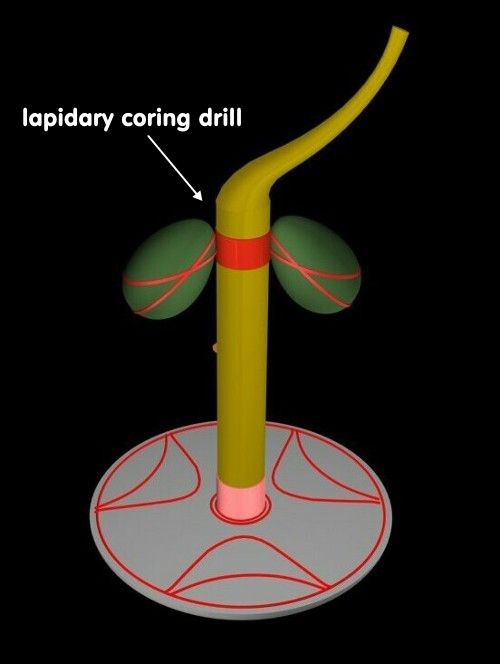
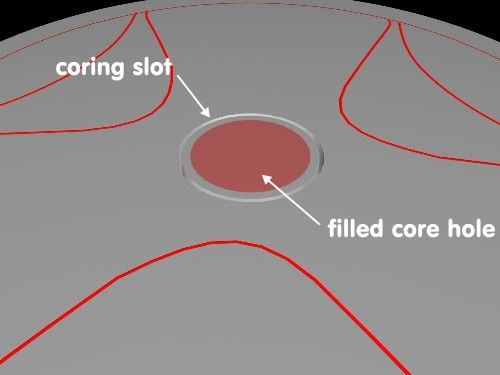
Another ancient Egyptian example of a rock tube cutting is presented in figure 19 and there are numerous examples of tube-shaped objects used as vessel stands (El-Khouli 1978).

Next, core holes may have been cut to remove as much of the waste rock as possible. This would be accomplished by cutting a series of holes around the periphery of the bowl, lobes, and then a few well-spaced holes in the exposed middle areas of waste rock (Fig. 20). Each hole would not pass completely through the vessel. The depth of each hole would be dependent on its position and the desired thickness of the bowl’s form. The cores could be snapped off with the aid of wedges driven into the sides of the core holes’ slots. After this is completed the remaining waste rock can be more easily removed by chiseling, grinding, and lapidary cutting.
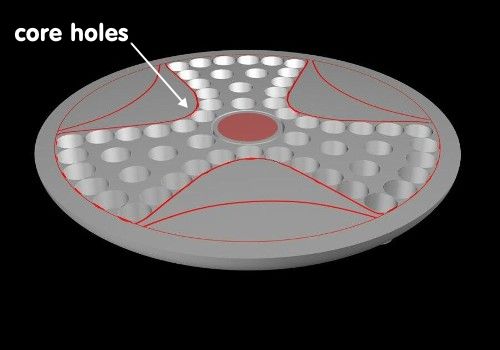
An example of this method is a partially completed porphyry vessel on display in the Cairo Museum (JE18758), demonstrating how the coring drill was used to remove waste rocks in the manufacturing of a stone vessel (Stocks 1999, image 1, image 2, image 3, image 4, image 5). This method of removing waste rock reduces the effort necessary for the manufacturing of stone vessels, and is a common timesaving technique still used today. Stocks (1999) also suggests a similar method was used in the manufacturing of sarcophagi, such as that in the King’s Chamber of the Great Pyramid, which still retains some of the tools marks from such a procedure (Fig. 21).

Three biconvex-shaped holes on the outer edge of the vessel would need to be carved as well, and this would be accomplished in a way similar to the removal of waste rock from the vessel’s interior, but in this case the core holes would be cut completely through the vessel. After this is completed, properly positioned, oversized pre-lobe forms remain (Fig. 22), and the cutting of these into the lobes would be next.

A likely course would be to carve the bottom of the lobe first. This could be done by carefully planning and drawing the max depths that the lodes will reach into the pre-lobe forms. Using this as a guild a series of cuts with a small lapidary saw would be used to remove as much of the waste rock as possible (Fig. 23). The oversized nature of the initial pre-lobe form adds strength to this area of the vessel and would aid in the cutting of these lobes with less risk of breakage. When the underside of the lobe is completed it would be finished with the use of grinding and polishing tools. The space under the lobe could be filled with something that would add strength during the rest of the working procedure.

The upper surface of the lobe would then be carefully and slowly ground down to the desired thickness to produce the finished lobe shape. The rest of the surfaces of the vessel would be finished in a similar way. The center tube also exhibits 2 parallel lines scribed onto its surface (Fig. 24). This could be accomplished with a thin cord made of an appropriate material (e.g. copper, leather, or sinew) and quartz abrasive. The cord in contact with abrasive could be slowly and gently pulled back and forth along the grooves changing the orientation of the vessel as this is done until the desired depth was obtained.

Ancient Egyptian Stoneworking Tools and Methods
a) Introduction
b) Copper slabbing saws
c) Copper coring drills
b) Stone vase making
e) Bead making
f) Relief carving
g) Stone sculpture carving
h) Lapping and polishing
References
Aldred, C. (1981) Egypt to the end of the Old Kingdom. McGraw-Hill, New York, 143 p.
Aston, B.G. (1994) Ancient Egyptian stone vessels: materials and forms. Heidelberger Orientverlag, Heidelberg, 196 p.
Clark, S. & Engelbach, R. (1930) Ancient Egyptian masonry. Oxford University Press, New York, 242 p.
El-Khouli, A. (1978) Egyptian stone vessels. Predynastic period to dynasty III v.1-3, Verlag Philipp von Zabern, Mainz am Rhein.
Emery, W.B. (1949) Great Tombs of the First Dynasty: Excavations at Saqqara v.1. Goverment Press, Cairo, 157 p.
Emery, W.B. (1972) Archaic Egypt. Penguin Books, Harmondsworth, 269 p.
Johnson, S.B. (1990) The cobra goddess of ancient Egypt: Predynastic, Early Dynastic, and Old Kingdom Periods. Kegan Paul International. New York, 276 p.
Lauer, J-P. (1976) Saqqara: the royal cemetery of Memphis: excavations and discoveries since 1850. Thames and Hudson, London, 248 p.
Lehner, M, (1997) The complete pyramids. Thames and Hudson, New York, 256 p.
Nicholson, P.T. & Shaw, I. (2000) Ancient Egyptian materials and techniques. Cambridge University Press, New York, 702 p.
Petrie, W.M.F. (c1974) Prehistoric Egypt. Aris & Phillips, Warminster, UK, 54 p.
Smith, W.S. (1981) The art and architecture of ancient Egypt. Yale University Press, 500 p.
Stocks, D.A. (1993) Making Stone vessels in Ancient Mesopotamia and Egypt. Antiquity, 67, 596-603.
Stocks, D.A. (1999) Stone sarcophagus manufacture in ancient Egypt. Antiquity, 73, 918-22.
Stocks, D.A. (2001) Testing ancient egyptian granite-working methods in Aswan. Upper Egypt, Antiquity, 75, 89-94.
Warden M. (2000) Recarving the Narmer Palette. Nekhen News, 12, 26-27. (PDF file)
Links
Ancient Egyptian Stone TechnologyHierakonpolis Online
Late Predynastic and Early Dynastic Egypt by Francesco Raffaele
Megaliths by Anthony Sakovich
Metropolitan Museum of Art The Egypt Archive Jon Bodsworth’s image archive of ancient Egyptian antiquities

